Starting with retinol? It’s a game-changer for skin, tackling everything from wrinkles to acne.
But knowing how often to use it is key. Too much too soon, and you might irritate your skin.
This guide breaks down the best way to introduce retinol, ensuring you get all the benefits without the drawbacks.
Key Takeaways
What is the Best Routine?
Finding the optimal routine for retinol use involves understanding your skin’s tolerance and gradually introducing the product to minimize irritation. This process ensures that you reap the benefits of retinol, such as enhanced skin texture, reduced wrinkles, and a clearer complexion, without overwhelming your skin.
If you have a sensitive skin, be sure to read more about common Winter Skin Diseases.
Below, we break down the steps to establish a retinol routine that works best for most people, emphasizing gradual introduction and adjustment based on skin response.
“The key is taking it slow – you can’t rush the results. Going too fast too soon won’t get you quicker results and is a recipe for irritation, as your skin won’t have time to adjust. And how often should you use retinol if you do react? You can increase your retinol use even more gradually if you feel your skin needs this slower approach.”
Initial Introduction

Week 1-2: Starting Off
- Begin with a retinol product that has a 0.3% concentration.
- Apply a pea-sized amount to clean, dry skin, focusing on areas most affected by signs of aging or acne.
- Limit applications to twice a week to allow your skin to adjust.
Monitoring and Adjustment
- Observe your skin for any signs of irritation, such as redness or peeling.
- If irritation occurs, reduce frequency to once a week until your skin adapts.
Gradual Increase
Week 3-6: Frequency Adjustment
- If your skin tolerates the initial frequency well, increase applications to three times a week.
- Continue to monitor your skin’s reaction, adjusting as necessary.
Week 7-8: Daily Introduction
- For those whose skin has adjusted with minimal irritation, consider applying retinol every other night.
- This step is crucial for building tolerance and ensuring your skin benefits from regular retinol use.
Advanced Considerations

Week 9-12: Concentration Increase
- Once your skin shows no adverse reactions to daily use, you may consider increasing the retinol concentration.
- Moving to a product with 0.5% retinol can offer more pronounced benefits, especially for persistent concerns.
Maintain Your Routine
Long-term Use and Care
- Consistency is key. Continue using retinol as part of your evening skincare routine, adjusting frequency as needed based on your skin’s ongoing response.
- Incorporate nourishing and hydrating products to support your skin’s health, such as moisturizers with hyaluronic acid or ceramides.
Additional Tips
- Sun Protection: Always apply a high-SPF sunscreen in the morning, as retinol can increase photosensitivity.
- Layering: Allow retinol to fully absorb before applying other skincare products to maximize its efficacy.
- Professional Guidance: For personalized advice, especially when considering higher concentrations or if you have sensitive skin, consult a skincare professional.
What if We Use Too Much?

Using too much retinol can lead to several unwanted side effects, as it significantly increases the likelihood of skin irritation and damage. Understanding these risks and knowing how to address them is crucial for anyone incorporating retinol into their skincare routine.
How to Recognize Overuse?
The first step is to identify signs of retinol overuse, which include:
- Increased Redness and Irritation: More frequent than normal skin irritation, including redness and a burning sensation.
- Peeling and Flakiness: Excessive dryness leading to visible peeling or flakiness of the skin.
- Sensitivity to Products: A newfound sensitivity to previously tolerated skincare products, including moisturizers and cleansers.
Immediate Actions
If you experience these symptoms, it’s important to take immediate steps to mitigate the effects:
- Pause Retinol Use: Temporarily stop applying retinol to allow your skin to recover.
- Moisturize: Introduce a gentle, hydrating moisturizer to help restore the skin’s barrier.
- Soothe the Skin: Products containing aloe vera or centella asiatica can calm irritation and reduce redness.
Long-term Adjustment

After addressing the immediate irritation, consider long-term adjustments to prevent future overuse:
- Reduce Frequency: Once your skin has healed, reintroduce retinol at a lower frequency than before, possibly starting with once a week.
- Lower Concentration: Consider using a retinol product with a lower concentration to lessen the potential for irritation.
- Consult a Professional: If unsure about how to proceed, seek advice from a dermatologist or skincare professional. They can provide guidance tailored to your skin’s specific needs.
Prevent Overuse
Prevention is key to avoiding the negative effects of retinol overuse. Here are strategies to ensure safe use:
- Follow Instructions: Adhere to the product’s usage instructions and recommendations closely.
- Listen to Your Skin: Pay attention to how your skin reacts and adjust usage accordingly. If signs of irritation appear, reduce frequency immediately.
- Incorporate Gradually: Especially when starting or changing retinol products, introduce them gradually to monitor skin tolerance.
Are There Good Alternatives?
While retinol is a powerhouse ingredient for addressing signs of aging, acne, and uneven skin texture, it’s not suitable for everyone. Skin sensitivity, adverse reactions, or personal preference might lead you to seek alternatives.
Fortunately, there are effective options available that can offer similar benefits with potentially fewer side effects. Here, we explore some of these alternatives, comparing their efficacy and highlighting both benefits and downsides relative to retinol.
Bakuchiol
Bakuchiol is a plant-derived compound that has gained popularity as a natural alternative to retinol. It can help reduce wrinkles and hyperpigmentation and improve skin elasticity without the irritation often associated with retinol.
It also presents an even better solution for acne.
Benefits
- Suitable for sensitive skin
- Less likely to cause redness, peeling, or irritation
- Can be used during the day
Downsides
- Limited research compared to retinol
- May not be as potent for severe skin concerns
Alpha Hydroxy Acids (AHAs) and Beta Hydroxy Acids (BHAs)

AHAs, like glycolic and lactic acid, and BHAs, such as salicylic acid, exfoliate the skin’s surface and within pores, respectively. They can improve skin texture, reduce fine lines, and clear acne, offering a different mechanism of action compared to retinol.
Benefits
- Immediate exfoliation results
- BHAs are excellent for oily and acne-prone skin
- AHAs help with surface hydration and sun-damaged skin repair
Downsides
- Potential for irritation and sun sensitivity
- May not target deep wrinkles as effectively as retinol
“As AHAs, BHAs, and retinoids are all types of chemical exfoliants, it isn’t recommended to combine these ingredients within the same routine. Otherwise, there’s a higher likelihood of irritation and skin barrier damage.“These ingredients should not be mixed and applied at the same time.”
Peptides
Peptides are short chains of amino acids that can signal skin to produce more collagen, leading to firmer, more youthful-looking skin. They are less irritating than retinol and can be a great alternative for those with sensitive skin.
Benefits
- Promote collagen production
- Can improve skin barrier function
- Generally well-tolerated by all skin types
Downsides
- Effects might be less dramatic compared to retinol
- High-quality peptide products can be expensive
Niacinamide

Niacinamide, or vitamin B3, has been shown to reduce inflammation, hyperpigmentation, and redness, as well as improve the skin’s barrier function. It’s a versatile ingredient that benefits almost all skin types.
Benefits
- Reduces inflammation and improves skin tone
- Strengthens the skin barrier
- Less irritating than retinol
Downsides
- May not be as effective for deep wrinkles
- Results can take longer to appear
Vitamin C
Vitamin C is a powerful antioxidant that can brighten the skin, reduce pigmentation, and stimulate collagen production. It’s an excellent choice for those looking to improve skin tone and texture.
If you are wondering whether you can mix it with retinol, the answer is yes. Here is a statement from Jacki Marzano about the proper routine with both ingredients:
“Start by using each ingredient 1-2 times per week, applying vitamin C in the morning and retinol at night. And always pair your routine with an SPF, (yes, even in winter), especially when using retinol since it can increase your skin’s sensitivity to the sun.”
Benefits
- Brightens skin and reduces pigmentation
- Antioxidant properties protect against environmental damage
- Stimulates collagen production
Downsides
- Can be unstable and degrade quickly if not properly formulated
- Some forms may be irritating for sensitive skin
FAQs
What to avoid when using retinol?
Avoid using retinol with other strong ingredients like benzoyl peroxide or alpha hydroxy acids to prevent irritation.
Can I use retinol under my eyes?
Yes, you can use retinol under your eyes, but apply it carefully and avoid getting it too close to the delicate eye area.
How long to leave retinol on face?
Apply retinol at night after cleansing, and let it absorb into your skin. Start with a low concentration and gradually increase to avoid irritation.
Do dermatologists recommend retinol?
Dermatologists often recommend retinol for its anti-aging benefits and acne treatment. Start slowly and consult a professional if needed.
Does retinol burn mean it’s working?
A mild tingling or burning sensation is normal when using retinol. It indicates the product is active, but severe irritation should be avoided.
Conclusion
To wrap up, finding the right balance with retinol or its alternatives is crucial for skin health. Whether you’re starting with retinol or opting for gentler options like bakuchiol or vitamin C, the goal is clear: improved skin with minimal irritation. Remember, the best results come from consistent use and listening to your skin’s needs. Start slow, stay informed, and adjust as you go to keep your skin looking its best.

